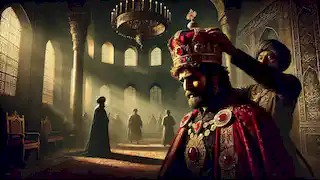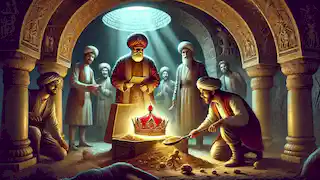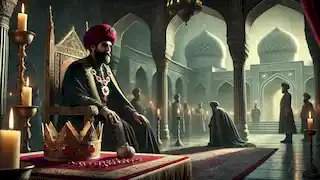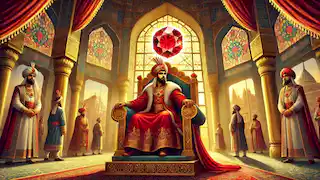In the heart of ancient Persia, where towering mountains met vast deserts, there was a kingdom known for its opulence and splendor. Its people, rich in culture and tradition, held dear to their monarchs and their legacies. Among the treasures of this kingdom, one artifact stood out above the rest: the Ruby Crown. This crown, encrusted with the finest rubies from distant lands, had a storied past that intertwined with the very history of the empire. Legends spoke of its mystical powers, capable of blessing its wearer with wisdom or cursing those who dared misuse its beauty. It was more than a symbol of power; it was a legacy that carried the spirit of Iran’s kings and queens throughout the ages.
This is the tale of how the Ruby Crown shaped the destiny of a nation, bringing together forces of love, betrayal, conquest, and magic. It is a story that stretches across centuries, revealing the untold secrets of the kings and queens who wore it and the price they paid for its grandeur. It was the dawn of a new age in Persia. The great King Khosrow I, known as "Anushirvan," was seated on his golden throne, gazing over his vast empire. The year was 531 AD, and under his rule, Persia had flourished like never before. The Silk Road pulsed with activity, carrying goods from the East and West, while scholars from distant lands gathered in the courts of Ctesiphon, exchanging knowledge on philosophy, science, and medicine. Amidst this golden era, the Ruby Crown was commissioned by King Khosrow to commemorate his reign. Crafted by the most skilled artisans from the royal treasury, the crown was adorned with a majestic ruby, the size of a fist, at its pinnacle. This ruby was said to have been found deep in the mountains of Badakhshan, and legends spoke of its blood-red glow as a divine gift. The completion of the crown marked the consolidation of Khosrow’s power, both as a warrior and a ruler. It was not just a symbol of his reign but also a reminder of his divine right to lead the empire. Khosrow, wise and just, was loved by his people. His reign was marked by prosperity, and the Ruby Crown became a cherished emblem, often displayed during important ceremonies. But the ruby itself carried secrets, some of which only the king knew. One night, as Khosrow meditated in the royal chambers, the ruby began to glow faintly. The king, startled, approached it with caution. As his hand hovered above the glowing gem, a voice whispered from within. “Great king, your reign shall prosper, but beware the blood of the ruby. It shall one day betray your line, and from the heart of your legacy, chaos shall rise.” King Khosrow withdrew his hand, unsettled. He had heard stories of cursed treasures, but this crown was meant to honor the gods, not invoke their wrath. Shaking off the ominous warning, he dismissed it as nothing more than the ramblings of his tired mind. But as time would tell, the Ruby Crown carried a curse that no ruler could escape. Decades after King Khosrow’s death, the Sassanian Empire faced turbulent times. His son, Hormizd IV, ascended the throne, wearing the Ruby Crown with pride. Yet his rule was fraught with internal strife and rebellion. A powerful general named Bahram Chobin, once loyal to the king, turned against him, accusing the court of corruption and mismanagement. Hormizd, suspicious of the growing power of his general, attempted to curb Bahram’s influence, but the tides of rebellion were already rising. Bahram gathered an army, and civil war broke out. In the midst of the chaos, Hormizd was betrayed by those closest to him. His own court, hungry for power and fearful of Bahram’s growing influence, conspired to depose the king. In a swift and brutal coup, Hormizd was captured. Stripped of his crown and bound in chains, he was forced to watch as his enemies celebrated his downfall. The Ruby Crown was taken from his head and placed on that of his son, Khosrow II, who had reluctantly allied himself with Bahram to save the throne. As the former king languished in prison, awaiting execution, he called upon the same ruby that had once whispered warnings to his father. “Reveal your secrets to me,” Hormizd demanded, but the ruby remained silent, its once vibrant glow dimmed by the weight of betrayal. In the months that followed, Khosrow II would reclaim his throne from Bahram, but the shadow of the coup and his father’s death lingered. The Ruby Crown, now restored to its rightful place, was no longer a symbol of unity but one of fractured loyalties. Years passed, and the Sassanian Empire faced an even greater threat: the rise of the Islamic Caliphate. In the year 636 AD, the Persian army met the forces of Caliph Umar at the Battle of al-Qadisiyyah. The clash was fierce, but the Sassanians, weakened by internal strife and betrayal, were no match for the disciplined Muslim army. King Yazdegerd III, the last of the Sassanian rulers, fled from one province to another, desperately trying to rally support. Everywhere he went, the Ruby Crown followed, a reminder of the empire’s former glory. But the crown’s power seemed to have faded. The ruby’s glow, once brilliant, had dulled over the years. The whispers that once spoke to the kings had fallen silent. In the final days of the empire, Yazdegerd sought refuge in the city of Merv, but even there, betrayal awaited him. His hosts, eager to curry favor with the new rulers, turned against him. On a fateful night in 651 AD, the last Sassanian king was assassinated, his blood staining the once pristine crown. The Ruby Crown, now a relic of a fallen empire, was lost to history. For centuries, its whereabouts were unknown, but the stories of its cursed power persisted. Some believed it had been taken by the Arabs, others claimed it was hidden away in a secret vault beneath the ruins of Ctesiphon, waiting for the day a new ruler would don it and restore Persia’s glory. Centuries later, in the 19th century, the crown reemerged. Persia, now ruled by the Qajar dynasty, was undergoing a period of transition. European powers vied for influence in the region, and amidst the political turmoil, rumors began to circulate about the Ruby Crown. It was during the reign of Nasir al-Din Shah, one of the longest-reigning monarchs of the Qajar dynasty, that the crown was discovered in a hidden chamber beneath the ruins of an ancient palace. The discovery sent shockwaves through the court. Historians, treasure hunters, and mystics all sought to uncover the secrets of the crown. Nasir al-Din Shah, fascinated by the legends surrounding the Ruby Crown, ordered it to be restored. He wore it proudly during state ceremonies, believing that its ancient power would solidify his rule and ward off foreign threats. But the whispers of the ruby had not been forgotten. Many in the court warned the king of the crown’s cursed history, but Nasir dismissed these concerns as mere superstition. The curse, however, was very much real. Within a few years of donning the Ruby Crown, Nasir al-Din Shah’s rule began to falter. His once firm grip on power loosened as internal dissent grew. The ruby, now glowing faintly once more, seemed to feed on the chaos around it. In 1896, the curse claimed its final victim. Nasir al-Din Shah, while visiting the shrine of Shah Abdol-Azim, was assassinated by a revolutionary. The Ruby Crown, drenched in the blood of yet another monarch, was returned to the royal vaults, where it would remain for the rest of the Qajar dynasty’s rule. The Ruby Crown has not been worn since the fall of the Qajar dynasty in the early 20th century. Today, it is preserved as part of Iran’s national treasures, locked away in a vault deep within the Central Bank of Iran. Its ruby no longer glows, and the whispers that once echoed through the halls of power are silent. But the legacy of the Ruby Crown endures. For generations, it has been a symbol of Persia’s grandeur, a reminder of the empire’s rise and fall, and a testament to the power and danger that come with the throne. Though its curse may be dormant, the stories surrounding it continue to captivate the imagination of historians and storytellers alike. In the end, the Ruby Crown is more than just a relic of the past. It is a reminder that the pursuit of power often comes with a price, one that can span centuries and echo through the ages. And perhaps, one day, the Ruby Crown will once again grace the head of a ruler, and its secrets will be revealed once more. The story of the Ruby Crown is a reflection of Iran’s turbulent history, a legacy marked by triumphs and tragedies, kings and queens, betrayals and victories. While the crown itself remains a silent witness to history, the lessons it imparts are timeless. Power, like the ruby at its center, is both beautiful and dangerous, capable of shaping the destiny of those who wield it.The Beginning of an Empire
The First Betrayal

The Fall of the Sassanian Empire

The Rediscovery

The Legacy of the Ruby Crown

Conclusion

















